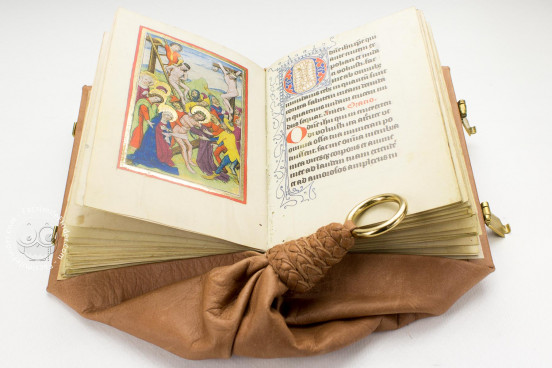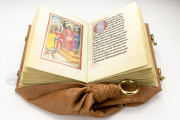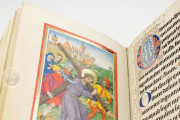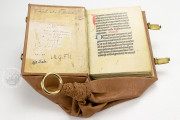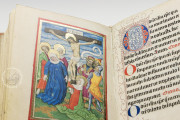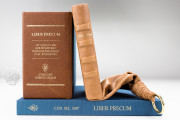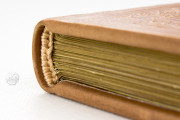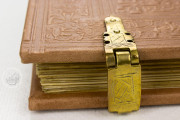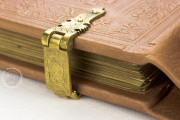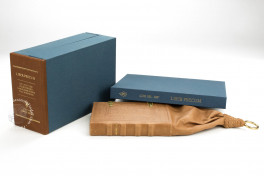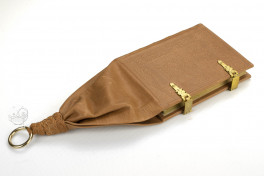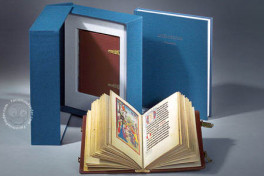Acquired by the National Library of Russia in 1929, the St. Petersburg Liber Precum is a hitherto overlooked masterpiece of late medieval book illumination from Cologne.
The manuscript combines two Latin texts, each written and decorated separately and apparently unique in the forms found in this book: the first portion of the manuscript is an illustrated series of prayers on the life and Passion of Christ (subject of the facsimile edition by ADEVA), and the second is a set of sermons and prayers in prose and verse, many attributed to distinguished spiritual authors, among them Saints Anselm, Gregory, Bernard, Jerome, and Thomas, as well as Jean Gerson and others.
A series of 41 full-page miniatures illustrating the prayers on the life and Passion of Christ
The Liber Precum belongs, broadly speaking, to the tradition of the Devotio Moderna, a religious reform movement, which by the mid-fifteenth century had spread from the northern Netherlands, where it originated, into large areas of the adjoining territories of Germany and the southern Low Countries; significantly, the Liber Precum begins with an excerpt from the first chapter of the Imitatio Christi of Thomas à Kempis, one of the founders and leading members of the Devotio Moderna.
The most distinctive feature of the manuscript is its complement of illustrations, which consists of an introductory historiated initial and a series of forty-one full-page miniatures illustrating the prayers on the life and Passion of Christ. Closely tied to the text of the prayers they accompany, the series of full-page miniatures is the fullest and most detailed narrative cycle of its type in any Cologne prayer book of the fifteenth century.
The Master of the St. Petersburg Liber Precum
With the publication of the St. Petersburg Liber Precum, we are able to reconstruct the oeuvre of a prominent painter active in Cologne during the third and fourth quarters of the fifteenth century (probably ca. 1470-90). In earlier scholarship, works by this painter were confused with the production of such figures as the Master of 1458; the considerably enlarged oeuvre of this painter can now be assigned to an independent artist, whom we name after this, his most important work, as the "Master of the St. Petersburg Liber Precum."
The St. Petersburg Liber Precum offers new evidence of the forms of devotional literature current in the Rhineland during the late fifteenth century.
The Master of the St. Petersburg Liber Precum assumes an important place in Cologne painting between the tradition of the painter-illuminator Stefan Lochner (d. 1451), which was emulated by workshop members and other followers well into the third quarter of the fifteenth century, and that of artists beholden to the traditions of early Netherlandish painting, such as the Master of the Life of Mary and members of his circle.
Miniature from the Master of the Liber Precum
The St. Petersburg Liber Precum offers new evidence of the forms of devotional literature current in the Rhineland during the late fifteenth century and of the use of pictorial imagery to enhance its effectiveness. It expands our knowledge of the scope and forms of picture cycles of the life and Passion of Christ in Cologne during this period, of relationships between the traditions of hand-produced and early printed books as well as manuscripts illustrated with prints, and it brings into focus the activity of one of Cologne's leading painters from ca. 1470-90.
The illustrated Prayerbook
The book of which the illustrated prayers on the life and Passion of Christ form the first portion (St. Petersburg, National Library of Russia, Ms. Lat. O.v.I, 206) is made up of two distinct sections.
The two sections of the book agree in some features of their layout, such as the number of lines of text per page (16) and the approximate size of their text columns, suggesting that whoever commissioned the second part of the book took care to insure that it conformed in some basic elements of its design to the first section. But the two portions of the book also differ in important codicological and stylistic features, including its quire structure, lineation, script and decoration.
These differences suggest that the first portion of the book (fols. 1-99), comprising the illustrated prayers on the life and Passion of Christ, was made at a different time and very likely also at a different locale from the second portion (fols. 100-280), comprising sermons and prayers.
We have 2 facsimiles of the manuscript "Book of Sermons":
- Der Liber Precum (Special Girdle Book Edition) facsimile edition published by Akademische Druck- u. Verlagsanstalt (ADEVA), 2003
- Der Liber Precum (Standard Edition) facsimile edition published by Akademische Druck- u. Verlagsanstalt (ADEVA), 2003

